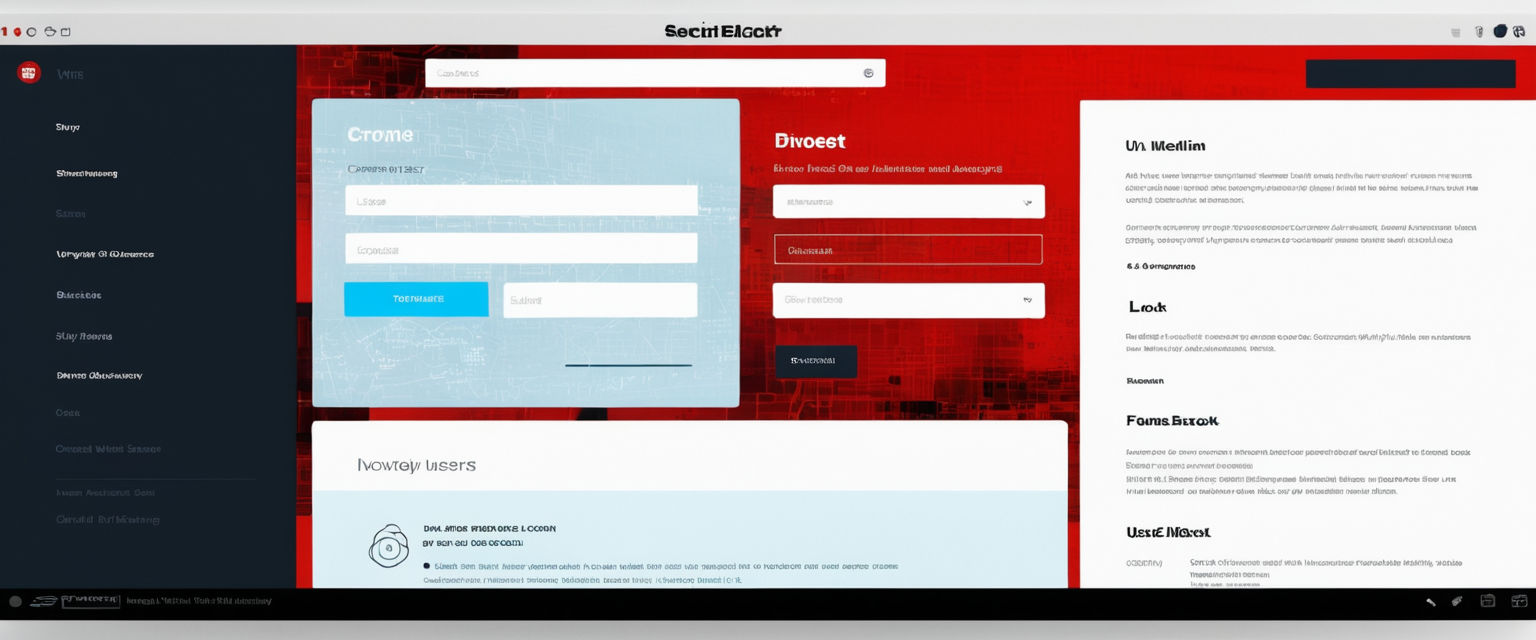
This comprehensive analysis examines the critical role of visual cues in distinguishing legitimate login pages from fraudulent phishing sites, with particular emphasis on how users can leverage visual indicators to protect encrypted login credentials and authentication information. The research reveals that while visual elements such as logos, security indicators, and URL formatting remain powerful tools for building user trust, cybercriminals have become increasingly sophisticated in manipulating these same elements to deceive victims. Modern phishing attacks exploit graphical elements with remarkable precision, with attackers creating thousands of fake login pages that mimic legitimate brands while simultaneously evading visual detection systems. The most significant finding is that users face a complex challenge: many commonly trusted visual indicators, including the security padlock icon, HTTPS protocols, and company logos, can be replicated by sophisticated threat actors. Understanding which visual cues are genuinely reliable and which can be manipulated is essential for protecting encrypted credentials and maintaining authentication security in an environment where visual deception has become both more common and more convincing.
The Visual Exploitation of Trust Elements in Phishing Attacks
The modern phishing landscape increasingly relies on the sophisticated manipulation of visual elements that users have learned to associate with legitimacy and security. Bad actors understand consumer behavior at a fundamental level, recognizing that in our increasingly visual digital world, people make rapid judgments based on graphical elements such as logos, color schemes, and typographical styles. This exploitation of visual trust markers has become one of the most effective vectors for credential theft, particularly in the context of login pages where users are already in a vulnerable cognitive state—focused on entering sensitive information and potentially distracted or hurried.
The psychology underlying this effectiveness stems from how humans process information. When confronted with a login page that displays a recognizable company logo, a professional layout, and familiar branding elements, most users experience a rapid assessment of trustworthiness that occurs almost instantaneously. This cognitive shortcut, while useful in most circumstances, becomes dangerous when threat actors invest time and resources in replicating these visual markers with high fidelity. According to security research, attackers have spoofed the world’s top 200 brands to create as many as 50,000 fake login pages, demonstrating the scale at which visual deception occurs. Remarkably, nearly 5 percent of these fake login pages were polymorphic, meaning they existed in multiple visual variations to evade detection systems and test different design approaches against user populations.
The most commonly exploited visual elements in phishing attacks include company logos, industry trust marks, and security indicators. Company logos represent the most frequently targeted visual element, not primarily because of any inherent security property they possess, but because phishing detection systems have historically struggled to identify logo-based phishing attempts. Attackers deliberately leverage this detection gap by using outdated versions of logos or making subtle modifications to confuse both automated systems and human observers. Among the brands most frequently impersonated in graphical phishing attacks are PayPal, Facebook, Microsoft, Netflix, and WhatsApp—all companies whose logos are instantly recognizable and whose login pages users visit frequently and sometimes urgently. When a user receives a notification about a problem with their Netflix account, for example, combined with the presence of the Netflix logo and a professional-looking login form, the urgency of the situation can override careful scrutiny of visual details.
Industry and trust marks represent another category of visual element that phishers exploit effectively. Many industries maintain marks or certifications that denote quality, security, and legitimacy—padlock icons indicating secure connections, SSL certificate indicators, payment brand logos, and various trust seals. Research has demonstrated that a significant portion of users misunderstand what these marks actually signify, creating opportunities for exploitation. In particular, studies examining user comprehension of the padlock icon found that approximately 23 percent of participants lacked a good understanding of what the icon represented, with some believing it was more trustworthy when displayed within website content rather than in the browser header. This misunderstanding is not merely academic; it has practical security consequences. When users misinterpret security indicators as proof of a website’s trustworthiness rather than simply proof of encryption, they become vulnerable to phishing attacks that use these indicators while hosting malicious login forms.
The effectiveness of logo-based phishing extends beyond simple visual copying. Threat actors have developed increasingly sophisticated techniques to bypass visual detection systems while maintaining enough visual authenticity to deceive human users. Advanced approaches include using HTML tables to recreate logos in ways that avoid image-based detection, manipulating favicon hashes to associate malicious domains with legitimate branding, and employing adversarial perturbation techniques that introduce subtle visual changes imperceptible to human observers but sufficient to confuse machine learning-based detection systems. These techniques represent an evolutionary arms race between defenders building visual detection systems and attackers finding new ways to manipulate or circumvent those systems while keeping fake pages visually convincing to end users.
URL-Based Visual Deception Tactics and Domain Spoofing
While graphical elements within login pages represent one category of visual deception, the URL itself serves as another critical visual indicator that users must evaluate to determine if they are accessing a legitimate login page. The URL appears at the top of every browser and represents one of the most fundamental visual cues available to users, yet research demonstrates that users frequently fail to examine URLs carefully before entering credentials. This failure occurs for multiple reasons, including the visual complexity of modern URLs, the speed at which users navigate the web, and deliberate design choices that make URLs less visible in some contexts.
Typosquatting represents one of the most straightforward URL-based deception tactics, involving the registration of domain names that differ from legitimate domains by only one or two characters. Common variations include swapping a single letter for a visually similar character, such as using the number “0” instead of the letter “O” to create “g00gle.com” instead of “google.com,” or substituting similar letters such as “r” and “rn” to create “goog1e.com” or “googme.com.” While these changes might seem obvious to someone actively scrutinizing a URL, users viewing these URLs in the context of a phishing email or in a browser address bar displayed in small text often fail to notice the discrepancy. The effectiveness of typosquatting is sufficiently high that registrants have purchased typo domains specifically for phishing purposes, with some attackers registering multiple variations of popular domains to capture traffic from various mistyping patterns.
Homograph attacks represent a more sophisticated URL-based deception technique that exploits the visual similarity of characters across different alphabets. In homograph attacks, attackers register domain names using characters from different writing systems that appear identical to Latin alphabet characters but are actually different Unicode characters. For example, the Cyrillic “а” (U+0430) is visually indistinguishable from the Latin “a” (U+0061), yet these represent different characters in Unicode encoding. An attacker could therefore register “exаmple.com” (using the Cyrillic “а”) instead of “example.com” (using the Latin “a”), creating a domain that appears identical to human observers but is technically a different domain. Browsers and DNS systems treat these as completely different domains, but visual inspection by humans fails to detect the substitution. When such domains are encoded for international domain names, they appear in Punycode format in certain contexts, such as “xn--exmple-9cf.com,” which provides no visual hint of the underlying homograph substitution unless users understand Punycode encoding.
Masked links represent another URL-based deception technique that has long plagued web security. In masked link attacks, the visible text of a hyperlink differs from the actual URL the link targets. A user might see a link that appears to say “https://www.google.com” but when clicked, actually navigates to an attacker-controlled phishing site. This technique exploits the HTML structure that separates link display text from actual link destinations, allowing threat actors to create links that appear to point to legitimate sites while actually directing users to malicious login pages. Many users do not routinely hover over links to preview the actual destination, particularly in email contexts where this capability may not be immediately obvious or available on mobile devices.
Open redirect vulnerabilities and similar attacks allow attackers to chain multiple redirects, obfuscating the final destination of a URL. An attacker might use a redirect chain where a user clicks on what appears to be a link to a legitimate service but is actually directed through multiple redirects that ultimately land on a phishing site. This technique proves particularly effective at bypassing security crawlers and email gateway filters that may examine only the initial URL rather than following the redirect chain to the final destination. More sophisticated variations use services like Cloudflare Turnstile for human verification, which requires user interaction to proceed, thereby creating additional barriers to automated detection while appearing legitimate to the user.
Security Indicators: Understanding Their Purpose and Limitations
The HTTPS protocol and the security padlock icon represent the most widely recognized visual indicators of website security, yet these indicators have become increasingly ineffective at distinguishing legitimate from fraudulent sites due to widespread misunderstanding about what they actually indicate. Understanding the distinction between a secure connection and a trustworthy website is critical for users attempting to evaluate login pages, as this misunderstanding directly enables phishing attacks.
HTTPS, or Hypertext Transfer Protocol Secure, establishes an encrypted connection between a user’s browser and a web server, ensuring that data transmitted between these two endpoints cannot be intercepted or modified by third parties. The protocol uses SSL (Secure Sockets Layer) or TLS (Transport Layer Security) certificates to establish this encryption and verify the identity of the server. When a website uses HTTPS, browsers historically display a padlock icon and, in some cases, green indicators in the address bar. The visual purpose of these indicators is to communicate to users that their connection is encrypted—not that the website is trustworthy or legitimate, but specifically that the connection itself is secure from eavesdropping.
However, extensive research demonstrates that users fundamentally misunderstand what the padlock represents. Surveys reveal that the vast majority of users interpret the padlock and HTTPS indicators as signs of website trustworthiness and safety rather than simply as proof of connection encryption. In research conducted by Chrome developers, 89 percent of surveyed users misinterpreted the padlock icon’s meaning, often construing it as an indicator that a website is safe and trustworthy. This misunderstanding has real security consequences because fraudulent websites can and regularly do obtain SSL/TLS certificates and use HTTPS. The barrier to obtaining an SSL certificate has become minimal, with many certificate authorities offering domain-validated certificates at no cost, requiring only proof that the applicant controls the domain in question. This means that a phishing site targeting bank.com can easily obtain an SSL certificate for phish-bank.com, resulting in a page that displays the padlock icon and HTTPS in the address bar while being a completely fraudulent site created specifically to steal login credentials.
The extent of this problem has become so widespread that major technology companies and government agencies have issued explicit guidance that the padlock icon alone cannot be trusted as an indicator of website legitimacy. The FBI, among other organizations, has published guidance specifically warning that the lock icon is not an indicator of website safety. In recognition of this problem, major browser vendors including Google Chrome have begun moving away from displaying the padlock icon for all HTTPS connections, recognizing that the presence of the icon was providing users with false confidence about website security. Chrome replaced the lock icon with a “tune” icon and reclassified the visual indicator as a site settings entry point rather than a security confidence indicator, reflecting the reality that HTTPS has become the norm rather than an exceptional security measure.
Extended Validation (EV) certificates represent a higher tier of SSL/TLS certificates that require verification of the requesting entity’s legal identity before certificate issuance. In theory, EV certificates provide stronger assurance because the certificate authority has verified that the organization requesting the certificate actually exists and is who they claim to be. Historically, browsers displayed EV certificates by showing the organization name in green text in the address bar, making it visually obvious that a higher level of validation had been performed. However, the use of EV certificates has declined significantly, with major websites abandoning them and browsers reducing their visual prominence. The practical impact of this decline is that even the most thorough verification mechanism available for SSL/TLS certificates has become less visible and less commonly used, leaving users with fewer visual cues to distinguish legitimate from fraudulent sites.
Trust badges and site seals represent visual elements that organizations place on their websites to indicate that the site has undergone some form of verification or security assessment. These badges typically come from third-party providers such as Norton, McAfee, or various industry-specific verification organizations, and clicking on them should reveal information about the verification that was performed. However, fraudsters frequently copy trust badges and place them on phishing sites without authorization, creating fake seals that appear to indicate security but actually indicate nothing. Users who see a recognizable trust badge may assume the website is legitimate without verifying the badge’s authenticity by clicking on it to see if it displays genuine verification information. The proliferation of both legitimate and counterfeit trust badges has made these indicators increasingly unreliable as visual cues for determining website legitimacy.

Visual Design Patterns of Legitimate Versus Fraudulent Login Pages
Beyond specific indicators like padlocks and logos, legitimate and fraudulent login pages can often be distinguished by analyzing their overall visual design patterns and the completeness of information they present. Legitimate companies typically maintain consistent branding standards and provide comprehensive information about their organization, while fraudulent pages often display telltale design inconsistencies that can alert careful observers.
Professional login pages typically feature consistent branding, clear typography, well-organized layouts, and information that helps users confirm they are on the correct site. Legitimate enterprise login pages often include multiple authentication options such as single sign-on capabilities, two-factor authentication options, and “remember me” functionality that allows frequent users to access their accounts more conveniently. The design of these pages reflects both security and usability principles, balancing the need to protect user credentials with the need to create a smooth user experience that encourages legitimate users to complete the login process. Pages designed by professional security teams typically include clear error messages that guide users to correct their input without exposing sensitive information, password visibility toggles that allow users to verify they have entered their credentials correctly, and visual indicators of password strength when users create new passwords.
In contrast, fraudulent login pages frequently display design inconsistencies that can alert observant users. Spelling and grammatical errors represent one of the most commonly noted indicators of fraudulent pages. While some errors may result from the attacker’s limited language skills, many phishers deliberately include misspellings and grammatical errors to filter out victims who are unlikely to fall for their scam, thereby improving the attacker’s efficiency in focusing on the most vulnerable targets. Beyond obvious errors, fraudulent pages frequently display inconsistent fonts, unusual color choices, misaligned elements, and layouts that seem unprofessional compared to the legitimate sites they attempt to replicate. However, this visual inconsistency varies widely depending on the sophistication of the attacker and the care they invest in replicating the legitimate site’s appearance. Well-resourced attackers or those using professional phishing kits can create pages with minimal visual discrepancies, making detection through design analysis alone increasingly difficult.
The “Contact Us” section of a website provides valuable visual information about whether a site is legitimate. Legitimate organizations typically display comprehensive contact information including physical addresses, phone numbers, email addresses, and in many cases, staff directories or social media links. Fraudulent sites frequently provide minimal contact information, often just an email address or sometimes no contact information at all, since the attacker has no legitimate organization to represent and adding fictional contact details increases the risk of those details being used to expose the fraud. Users can often verify a site’s legitimacy by searching online for contact information from the purported organization and comparing it with what is displayed on the suspicious site. If the site claiming to represent a bank provides a phone number that differs from the number listed on the bank’s official website, this represents a significant red flag.
The presence and nature of advertisements provides another visual cue about site legitimacy. Websites that are predominantly advertisements with minimal content typically indicate a low-quality or potentially fraudulent site. Legitimate company websites prioritize their own branded content and services over advertising, whereas phishing sites or lower-quality sites often depend on advertising revenue and therefore display ads prominently. An excess of intrusive pop-ups, redirects to unrelated sites, or advertisements offering unrealistic products or services should alert users that they may not be on a legitimate website. However, this distinction has become less reliable as some sophisticated phishing operations invest in creating visually polished pages with minimal advertising to appear more legitimate.
Advanced Visual Deception Techniques and Emerging Threats
As users have become more aware of common phishing indicators, threat actors have developed increasingly sophisticated visual deception techniques designed to circumvent both human and automated detection. These advanced techniques represent an evolutionary response to improved user awareness and enhanced detection systems, demonstrating that the threat landscape continues to advance alongside defensive measures.
Adversarial visual component manipulation represents a sophisticated approach to creating phishing pages that evade visual detection systems while remaining visually convincing to human observers. In adversarial attacks, threat actors apply subtle perturbations to visual elements such as logos, making small changes that are either imperceptible or nearly imperceptible to human vision but sufficient to confuse machine learning models trained to detect phishing through visual similarity. For example, an attacker might change the facebook logo from lowercase letters to uppercase letters, adjust font weights, or alter colors in ways that humans would likely not notice but that cause visual detection systems to fail to recognize the logo as a replica of the legitimate one. These attacks exploit the difference between human and machine perception, allowing attackers to create pages that remain visually convincing to users while evading automated defenses.
QR code phishing represents an emerging threat that leverages visual trust in QR codes themselves. QR codes are machine-readable images that users scan with mobile devices to access information or visit websites. Threat actors now embed phishing URLs within QR codes included in phishing documents, typically themed around topics like payroll or human resources to increase the likelihood that users will scan the codes without careful evaluation. The mobile-first nature of QR code interaction creates a particular vulnerability because when users scan QR codes on their smartphones, they bypass some of the desktop-based security measures their organizations may have implemented, such as email gateways and web filters. Additionally, attackers use sophisticated techniques such as Cloudflare Turnstile to implement human verification within redirect chains, making it more difficult for security scanning systems to detect the actual phishing destination while appearing legitimate to users who have already begun the authentication process.
Favicon manipulation represents a lesser-known but increasingly important visual deception technique. Favicons are small images displayed in browser tabs, address bars, and bookmarks that users associate with websites. By copying the favicon from a legitimate domain and hosting it on a phishing site, attackers can create additional visual continuity that makes the fraudulent page appear more legitimate. Researchers have discovered that favicon hashes can be used to identify vulnerable infrastructure at scale, and attackers exploit this by using stolen or replicated favicons to make their malicious infrastructure appear to match legitimate domains in visual comparison tools and browser displays.
Live-streaming and dynamic adaptation in phishing attacks has introduced another layer of visual deception. Some sophisticated phishing operations now use real-time manipulation of page content, displaying different visual elements depending on characteristics of the user accessing the page or the security tools analyzing the page. These adaptive phishing sites can show legitimate content to security scanners while displaying phishing content to actual users, or adjust their visual appearance based on the browser, device type, or geographic location of the visitor. This dynamic adaptation makes static visual analysis ineffective at determining whether a login page is fraudulent.
Password Managers and Visual Verification Mechanisms
Password managers represent a significant security tool for protecting encrypted login credentials, functioning partly through visual verification mechanisms that help users avoid entering credentials into fraudulent login pages. The autofill functionality of password managers operates by examining the domain of the website where the user is attempting to log in and comparing it against the saved URLs in the password manager’s database. When autofill is configured to require manual activation rather than operating automatically, it creates an additional opportunity for visual verification that can prevent phishing attacks.
The most significant protection provided by password manager autofill comes not from automatic credential entry but from the visual verification moment when users must consciously approve autofill. When configured properly, password managers perform background domain verification without displaying credentials on malicious pages. If a user navigates to a fraudulent login page and attempts to autofill their credentials, a properly configured password manager will recognize that the domain does not match the saved domain for those credentials and will refuse to autofill, immediately alerting the user to the possibility that they have accessed a fake login page. This visual moment—when expected autofill fails to appear—can serve as a critical alert that something is wrong.
However, password managers themselves are vulnerable to a sophisticated attack known as AutoSpill, which was discovered affecting multiple password managers including 1Password, LastPass, Enpass, Keeper, and KeePass2Android. In AutoSpill attacks, malicious websites include multiple invisible form fields on their pages, causing password managers to inadvertently fill credentials into unexpected fields where attackers can capture them. This attack exploits the visual assumption that visible form fields are the only ones present on a page. The solution to this vulnerability is to configure password managers to use manual rather than automatic autofill, which introduces a visual verification step that allows users to examine the page and confirm it looks legitimate before approving credential entry. While manual autofill is less convenient than automatic filling, it provides the critical visual verification moment necessary to detect sophisticated phishing attempts.
Some advanced password managers incorporate visual cues within their autofill interface to indicate whether the current website matches the saved domain and to display information about certificate validation and site security status. When users see the password manager display clear visual confirmation that the domain matches, this provides reassurance that they are on the correct site. Conversely, when the password manager cannot confirm a domain match or when it displays warnings about the site’s security status, users receive a visual alert to exercise additional caution.

Human Factors: Psychology of Visual Deception in Login Scenarios
The effectiveness of visual phishing deception cannot be understood without examining the psychological factors that cause users to misinterpret or overlook visual cues, even when those cues are presented clearly. Cognitive science research on attention, memory, and decision-making has revealed multiple mechanisms through which legitimate visual indicators of security can be compromised by human factors.
Inattentional blindness represents one of the most significant cognitive phenomena affecting phishing detection. Inattentional blindness refers to the failure to notice something that is completely visible because of a lack of attention. Users focused on completing a task, such as logging into their email account quickly, may entirely fail to notice visual discrepancies in domain names, spelling, or other design elements that would be obvious to someone examining the page with full attention. A famous study demonstrating inattentional blindness involved showing participants a video of people passing basketballs and asking them to count passes; more than 50 percent of participants failed to notice a person in a gorilla costume walking through the scene, despite it being clearly visible on screen. This demonstrates that even highly visible anomalies can be completely overlooked when observers are focused on a primary task. In the context of phishing login pages, a user’s primary task is entering their credentials, and this focus can cause them to overlook visual inconsistencies in the page’s design or URL.
Security fatigue represents another psychological factor that increases vulnerability to phishing attacks. Security fatigue occurs when users are prompted to authenticate repeatedly, causing them to experience reduced vigilance and increased susceptibility to phishing attempts. Research examining whether repeated login prompts reduce phishing susceptibility found that users who were prompted to authenticate more frequently maintained awareness similar to control groups, yet they displayed higher susceptibility to well-crafted spear phishing attacks. This suggests that repeated exposure to authentication requests can reduce the careful visual examination that should accompany login processes, making users more vulnerable to visual deception.
Emotional triggers deliberately embedded in phishing emails and phishing pages directly impact how carefully users examine visual cues. Phishers leverage emotions such as urgency, fear, curiosity, and excitement to create cognitive states where users are less likely to carefully examine visual details. When a user receives a message claiming that their bank account has been compromised and demanding immediate action, the emotional response of fear can override careful visual evaluation of whether the login page is legitimate. Similarly, messages designed to trigger excitement (such as claims of unclaimed money or prizes) can cause users to overlook visual inconsistencies that would be obvious in a calmer cognitive state.
Trust in familiar visual elements creates both protection and vulnerability. When users see logos from trusted companies, they experience a rapid, almost automatic sense of trust that can override deliberate evaluation of other visual cues. This rapid trust response evolved to be adaptive in most situations, but it becomes problematic when threat actors can easily replicate the visual elements that trigger this trust response. Phishers deliberately exploit this by ensuring that the most visible visual elements (logos, color schemes, branded language) are accurate replicas of legitimate sites, knowing that users who see these familiar elements will experience a sense of trust that prevents them from carefully examining other aspects of the page.
Spelling and grammar provide another example of how psychological factors affect visual phishing detection. Research examining why phishers include spelling and grammatical errors revealed that these errors are often deliberate and serve multiple psychological purposes. First, errors help the attacker identify victims likely to fall for the scam by causing non-gullible recipients to immediately distrust the message and stop engaging, thereby allowing the attacker to focus on more promising targets. Second, minor errors in communications that would normally come from professional organizations actually seem more authentic and relatable to some recipients, helping to build the rapport that sophisticated social engineering requires. This means that while obvious errors can serve as visual warnings to careful observers, the presence of minor errors may actually increase the credibility of the message to some recipients who view the errors as making the communication seem more human and authentic.
Best Practices for Evaluating Visual Cues on Login Pages
Given the complexity of visual deception in phishing and the limitations of traditional visual indicators, users require practical strategies for evaluating login pages before entering encrypted credentials. These best practices combine technical verification methods with careful visual examination and healthy skepticism.
The most fundamental recommendation is to avoid clicking on links in unsolicited emails, messages, or advertisements that direct to login pages. Instead, users should manually type trusted domain names directly into their browser address bar or use bookmarks to access login pages. This practice bypasses the vulnerability created by masked links and domain-spoofing techniques, as it ensures that the domain being accessed is exactly what the user intends rather than what an attacker has created to appear legitimate. While this practice requires slightly more effort than clicking links, it provides decisive protection against URL-based deception.
Careful examination of the URL before entering credentials provides an additional layer of protection. Users should take a moment to visually verify that the domain name is spelled correctly and matches the legitimate site they intend to access. This examination becomes easier when the user slows down and consciously focuses on the domain rather than rushing through the login process. Hovering over links in emails before clicking them reveals the actual destination, allowing users to verify that the link actually goes where it claims to go. On mobile devices where hovering is not possible, users should long-press links to see where they actually direct before clicking.
Examining the contact information and other indicators of organizational legitimacy provides additional confirmation that a site is genuine. Users can verify a site’s contact information by searching for the official number or address from the official website and comparing it with what is displayed on the suspicious page. If the contact information differs or appears incomplete, this represents a red flag. Users should also check for things like privacy policies, terms of service, shipping and return policies (for e-commerce sites), and other documentation that legitimate organizations maintain but fraudsters often omit or copy directly from other sites without modification.
The use of multi-factor authentication (MFA) and TOTP (Time-Based One-Time Password) represents a critical security practice that significantly reduces the damage caused by compromised credentials even if users accidentally enter them into fraudulent login pages. Even if an attacker obtains a user’s username and password through a phishing login page, they cannot access the account if the account requires a second authentication factor that the attacker does not possess. For this reason, enabling all available authentication factors on important accounts provides protection that goes beyond visual evaluation of login pages.
Password managers with appropriate configuration provide valuable protection through both technical and visual verification mechanisms. By enabling manual autofill rather than automatic autofill, users create a moment where they must consciously approve credential entry, allowing them to pause and visually examine the page before confirming that they are on a legitimate site. Additionally, password managers that check domain matching and display security indicators provide visual feedback about whether the current page matches saved credentials and security status information about the site’s certificate and protection status.
Using website security checking tools provides an objective assessment of whether a domain has been flagged as malicious or fraudulent by security organizations. Tools such as Google Safe Browsing, URLVoid, and other website reputation checkers examine domains against databases of known malicious sites and provide trust scores based on multiple security data sources. While these tools cannot identify brand-new phishing sites that have not yet been flagged, they provide valuable protection against sites used in widespread phishing campaigns that have already been identified as threats.
Browser security features, including phishing filters and malware detection, provide automated visual warnings when users navigate to potentially dangerous sites. Modern browsers display warning pages before allowing access to sites flagged as phishing or malware hosts, providing clear visual indications that the site may be fraudulent. While these protections are not perfect and sophisticated attackers occasionally evade them, they represent important automated defenses that complement visual evaluation by users.
Recognizing Emerging Visual Deception Patterns
As threat actors continue to evolve their techniques, users and security professionals must recognize emerging patterns in visual deception that represent new vulnerabilities. The increasing sophistication of visual phishing attacks suggests that traditional visual indicators will become less reliable over time, requiring continuous adaptation of detection and prevention strategies.
The integration of legitimate website redirects into phishing chains represents an emerging deception pattern that exploits users’ tendency to trust URLs that appear to come from legitimate domains. When threat actors use open redirects or legitimate redirect services to chain multiple redirects that ultimately land on a phishing site, the initial redirect URL may appear legitimate, causing users to trust it. This technique exploits the assumption that a URL beginning with a known legitimate domain is inherently trustworthy, when in fact that URL might be configured to redirect to a completely different destination.
The use of artificial intelligence to improve phishing email quality represents another emerging threat that reduces the visibility of traditional warning signs. AI-based writing assistants can now generate phishing emails with grammatically correct text that closely mimics the tone and style of legitimate organization communications, eliminating the spelling and grammatical errors that previously served as visual warnings. As AI-generated phishing becomes more prevalent, users will need to rely less on text-based indicators and more on domain verification and technical security measures.
The evolution of QR code phishing and similar image-based deception techniques demonstrates how visual threats adapt to new technologies. As users become more comfortable scanning QR codes and interacting with image-based links, threat actors increasingly use these vectors for phishing attacks because they bypass traditional email-based security measures and take users directly to mobile browsing environments where additional security controls may not be active.
Empowering Your Eye: The Visual Defense
The visual indicators available to users for distinguishing legitimate login pages from fraudulent ones have become increasingly complex and, in many cases, less reliable than historical precedent would suggest. While traditional visual cues such as logos, URLs, security padlock icons, and company branding continue to influence user perception of legitimacy, sophisticated threat actors have demonstrated remarkable ability to replicate these same indicators in fraudulent pages designed specifically to steal encrypted login credentials. The fundamental challenge facing users today is that the visual elements humans have learned to trust as indicators of security and legitimacy are largely reproducible, while the technical indicators that genuinely provide security verification (such as HTTPS and certificate validation) are so commonly misunderstood that they often increase user confidence in fraudulent sites rather than legitimate ones.
The most reliable visual cues for evaluating login pages involve not any single indicator but rather a combination of approaches that include careful domain name verification, examination of organizational legitimacy indicators, evaluation of design consistency and professionalism, and use of automated tools that verify whether a domain has been flagged as malicious. Users who deliberately slow down their login process, avoid clicking links in unsolicited messages, and verify information across multiple sources significantly reduce their vulnerability to visual phishing deception. Password managers with appropriate configuration provide important technical safeguards that combine visual verification mechanisms with domain matching to prevent credential theft even if users accidentally navigate to fraudulent pages.
Looking forward, the continued sophistication of visual deception techniques suggests that user awareness and careful visual evaluation, while important, will be insufficient as standalone defenses. The most effective approach to protecting encrypted login credentials will combine user education about common visual deception tactics with technical defenses including multi-factor authentication, advanced email security systems that detect visual phishing at scale, and continuous evolution of browser-based protections that verify website legitimacy through mechanisms beyond what users can easily evaluate visually. Organizations should invest in comprehensive security awareness training that teaches employees not just what phishing looks like, but why visual indicators can be misleading and how to apply skepticism and verification techniques before trusting visual cues on login pages. The psychology of visual trust, when combined with the technical sophistication of modern phishing attacks, creates a threat environment where no single approach provides complete protection, requiring instead a multi-layered strategy that acknowledges both the power and the limitations of human visual perception in security contexts.
Protect Your Digital Life with Activate Security
Get 14 powerful security tools in one comprehensive suite. VPN, antivirus, password manager, dark web monitoring, and more.
Get Protected Now





